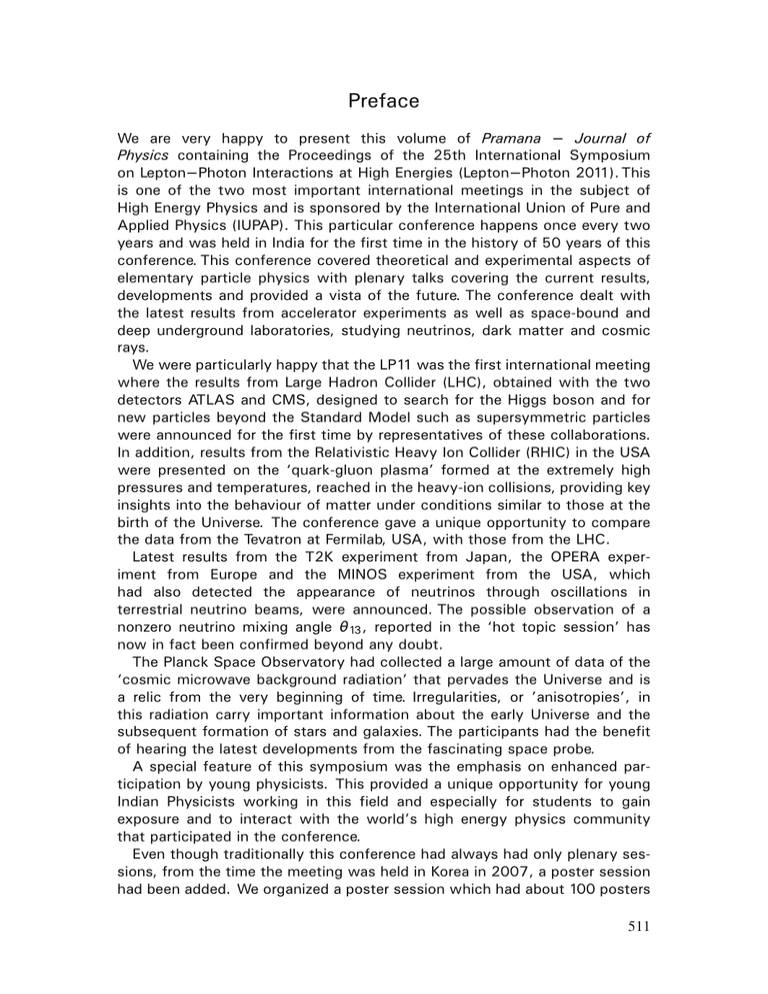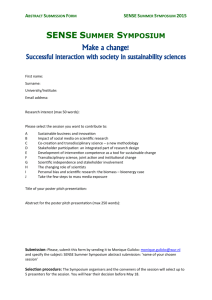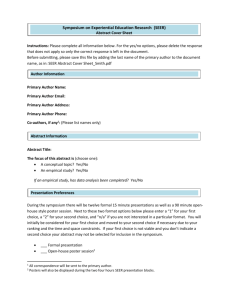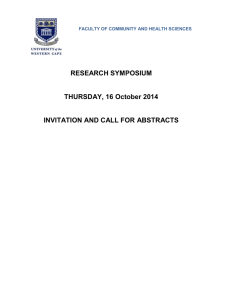Preface
advertisement

Preface We are very happy to present this volume of Pramana − Journal of Physics containing the Proceedings of the 25th International Symposium on Lepton−Photon Interactions at High Energies (Lepton−Photon 2011). This is one of the two most important international meetings in the subject of High Energy Physics and is sponsored by the International Union of Pure and Applied Physics (IUPAP). This particular conference happens once every two years and was held in India for the first time in the history of 50 years of this conference. This conference covered theoretical and experimental aspects of elementary particle physics with plenary talks covering the current results, developments and provided a vista of the future. The conference dealt with the latest results from accelerator experiments as well as space-bound and deep underground laboratories, studying neutrinos, dark matter and cosmic rays. We were particularly happy that the LP11 was the first international meeting where the results from Large Hadron Collider (LHC), obtained with the two detectors ATLAS and CMS, designed to search for the Higgs boson and for new particles beyond the Standard Model such as supersymmetric particles were announced for the first time by representatives of these collaborations. In addition, results from the Relativistic Heavy Ion Collider (RHIC) in the USA were presented on the ‘quark-gluon plasma’ formed at the extremely high pressures and temperatures, reached in the heavy-ion collisions, providing key insights into the behaviour of matter under conditions similar to those at the birth of the Universe. The conference gave a unique opportunity to compare the data from the Tevatron at Fermilab, USA, with those from the LHC. Latest results from the T2K experiment from Japan, the OPERA experiment from Europe and the MINOS experiment from the USA, which had also detected the appearance of neutrinos through oscillations in terrestrial neutrino beams, were announced. The possible observation of a nonzero neutrino mixing angle θ13 , reported in the ‘hot topic session’ has now in fact been confirmed beyond any doubt. The Planck Space Observatory had collected a large amount of data of the ‘cosmic microwave background radiation’ that pervades the Universe and is a relic from the very beginning of time. Irregularities, or ’anisotropies’, in this radiation carry important information about the early Universe and the subsequent formation of stars and galaxies. The participants had the benefit of hearing the latest developments from the fascinating space probe. A special feature of this symposium was the emphasis on enhanced participation by young physicists. This provided a unique opportunity for young Indian Physicists working in this field and especially for students to gain exposure and to interact with the world’s high energy physics community that participated in the conference. Even though traditionally this conference had always had only plenary sessions, from the time the meeting was held in Korea in 2007, a poster session had been added. We organized a poster session which had about 100 posters 511 512 Preface covering all the different experiments as well as theory. These were selected after careful scrutiny by a committee that was set up for the purpose. The posters thus selected and presented by members of the various collaborations were scrutinized by expert committees and six best poster awards were presented. These consisted of books. We thank The World Scientific Publishers for providing us with some of the books we used for this purpose. We thank the International Advisory Committee, the National Organizing Committee and members of Tata Institute of Fundamental Research (TIFR), India for their invaluable contributions, and unstinted support for making this symposium an intellectually rewarding and enjoyable event. Several individuals played key roles in the smooth functioning of the symposium. We specially thank B Satyanarayana, S D Kalmani, P Verma, M Saraf, P Nagaraj, and D Samual for coordinating many activities associated with this symposium. Finally we gratefully acknowledge the sponsors of the conference: Department of Atomic Energy, Government of India; IUPAP, DESY, Germany; HarishChandra Research Institute, Allahabad; Institute of Mathematical Sciences, Chennai; International Union of Pure and Applied Physics; Saha Institute of Nuclear Physics, Kolkata and Tata Institute of Fundamental Research, Mumbai for their generous financial support. Rohini Godbole Indian Institute of Science, Bangalore 560 012, India Naba K Mondal Tata Institute of Fundamental Research, Mumbai 400 005, India (Editors)



